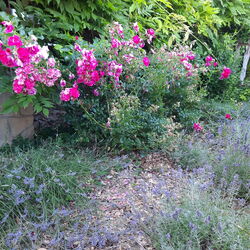Small-scale organic rarming in Zala
Péter Bakos and his wife Zsuzsa left their former careers behind to start farming, building their model farm step by step. Here, they grow and process herbs, fruits, and spices into 100% pure juices, dried fruits, infused oils, essential oils, and floral waters. What makes them unique is their commitment to human-scale, artisanal production.Visitors can tour the workshop, taste natural delicacies, and learn firsthand about the healing power of herbs.
Where people, animals, and plants thrive together
Drawn to a sustainable, nature-connected lifestyle, Péter and Zsuzsa settled in Zalaszentlászló. Though they once lived in Budapest, their love for nature and interest in herbalism had always been there. When they found their property in the Zala Valley, they quickly realized its potential — wild herbs flourished everywhere.
Over time, this blossomed into the Valley of Herbs. Their vision was simple: create a place where nature sets the rhythm, and the family only takes what each season offers. To deepen her knowledge, Zsuzsa completed formal phytotherapy training, gaining a deep understanding of the valley’s medicinal plants.
Tradition meets modern processing
In their “witch’s kitchen,” Valley of Herbs produces infused oils, dried fruits, pure juices, and herbal teas — all from natural, carefully selected ingredients. Modern pressing technology ensures minimal intervention for juices, while crafting infused oils, drying fruits, and preparing teas remains a hands-on, meticulous process.
Every herb, spice, and fruit is sorted by hand before it goes into oils, dehydrators, or drying racks. Unlike industrial producers, Péter and Zsuzsa focus on quality over quantity. They use only their own crops or ingredients from trusted local farmers. Herbs are homegrown or wild-harvested from their land. Their infused oils are blended with omega-3 rich Hungarian oil and flavored with homegrown basil, garlic, tarragon, and thyme.Dried fruits — apricots, plums, apples, sour cherries — are gently dehydrated at low temperatures to preserve their natural flavor and nutrients.
Juices are pressed from seasonal harvests — apples, grapes, rowanberries, currants, beets, and pumpkins — without added sugars or preservatives.
A little of everything in one place
Their 15-hectare farm is a vibrant mix of wild meadows, orchards, herb gardens, and a fragrant spice patch. Chickens, roosters, and horses are part of daily life, cared for by Zsuzsa with joy. The farm also includes a small on-site shop, where, by appointment, visitors can buy their favorite products, join herb walks, and attend educational workshops.
Product highlights
Dried fruits – Local, natural, handcrafted
Valley of Herbs dried fruits are made exclusively from local, hand-selected produce. Only the best fruits are used — anything bruised or overripe is carefully excluded to maintain top quality in taste and appearance. Apples, pears, and plums are hand-picked, pitted, sliced, and gently dehydrated using an eco-friendly, small-scale drying system.
Dried slowly at low temperatures (45–55°C) over several hours or even days, the fruits retain their color, vitamins, and natural sweetness. No added sugar, no preservatives — just the pure, sun-ripened flavor and aroma of the fruit.
Where to buy the products:
- 8788 Zalaszentlászló, Vörösmajor 0154
- Google Maps
More information & Contact:
The Life-Giving Winds of the Ice Age: How Loess Shaped the Land Did you know that Transdanubia’s rich, golden soils are actually a gift from the winds of the Ice Age? Loess isn’t just a dry geological term — it’s an ancient natural recipe that gave rise to some of the most fertile soils in the Carpathian Basin. Where vineyards grow today and birds nest in loess cliffs, strong winds once carried yellow dust across the landscape — for thousands of years. Learn how this unique sediment shaped the land and why loess is still essential for sustainable farming today. What Is Loess and How Did It Form? The term loess comes from the German word lose, meaning "loose." Loess is a fine-grained, yellowish sediment that was deposited during the Pleistocene epoch (2.58–0.01 million years ago), particularly during glacial periods. It formed in periglacial environments south of the great Scandinavian ice sheet — cold, dry landscapes with little or no vegetation. The dust was carried by strong Ice Age winds from floodplains and barren steppes, and slowly accumulated over tens of thousands of years. Eventually, calcium carbonate cemented these layers into loess, which developed characteristic vertical fissures. It’s important to note that the Pleistocene wasn't a single “Ice Age,” but a period that included alternating cold and warm phases — some even warmer than today. Loess and the Landscape Loess gave the Carpathian Basin — especially Transdanubia — its distinct terrain. Steep loess cliffs (sometimes up to 10 meters high), caves that provide nesting sites for bee-eaters and sand martins, centuries-old sunken roads carved into hillsides, and exposed root systems are all part of the landscape’s geological legacy. Together, they define the unique character of this region — shaped by time, wind, and stone. Fertility and Water Retention Loess-rich areas have produced some of the most fertile soils in the region. Many local producers farm on land that sits atop loess. This creates an excellent foundation for agriculture — not just because of the high humus content, but also because loess has outstanding water-holding capacity. Its vertical pores allow moisture to penetrate deeply and remain in the soil, even during dry periods. A Modern Echo — Dust from the Sahara Interestingly, the fine Saharan dust that now reaches Central Europe more frequently can be seen as a modern counterpart to loess-forming material. It’s a reminder that the powerful natural forces that shaped the land long ago are still at work today — just on a different scale.















